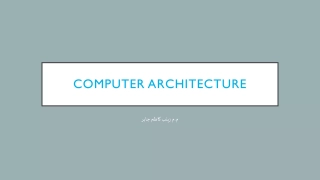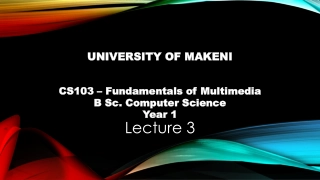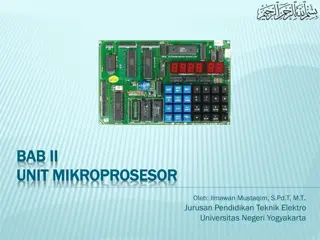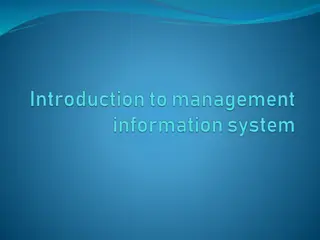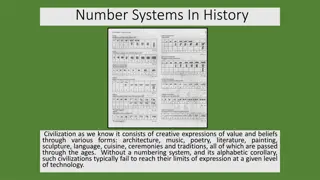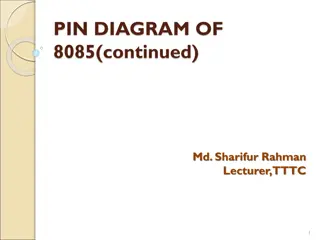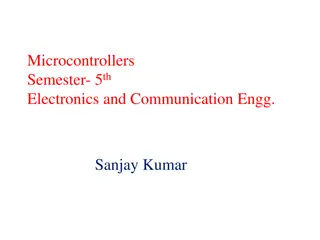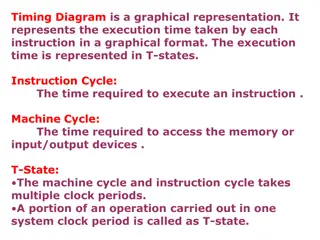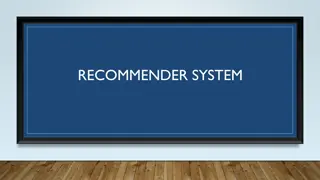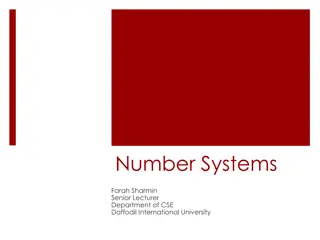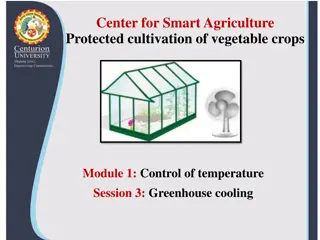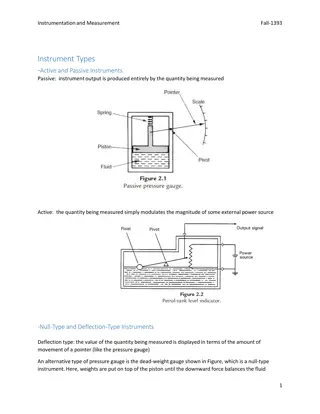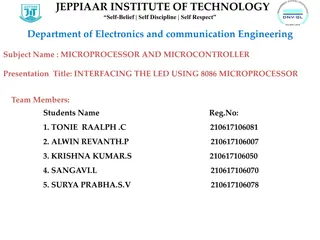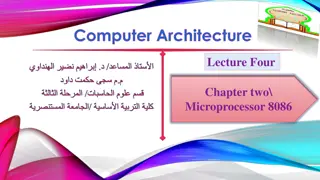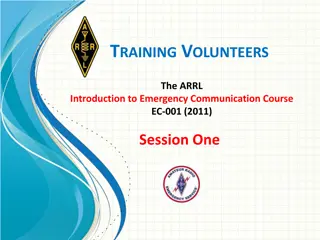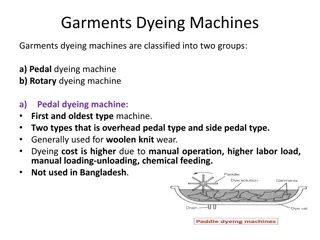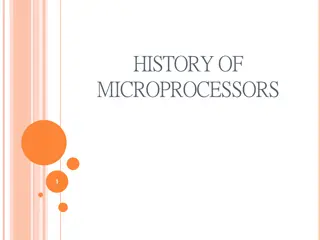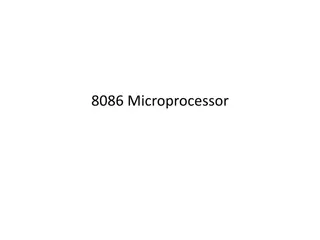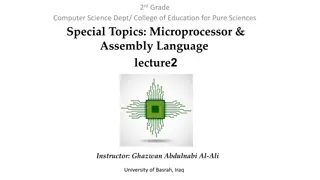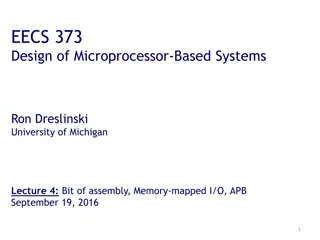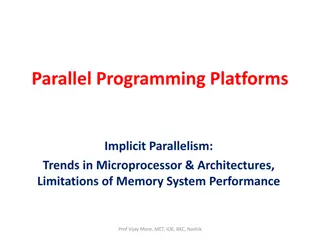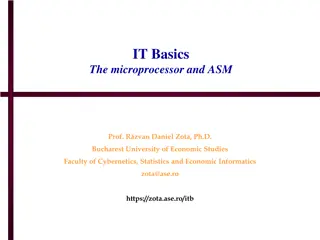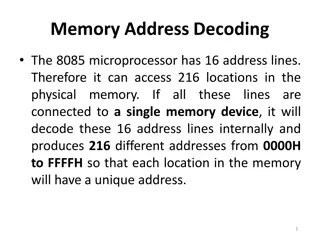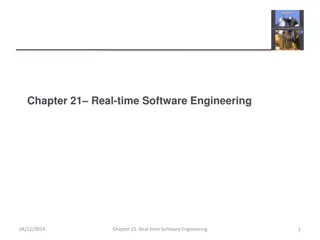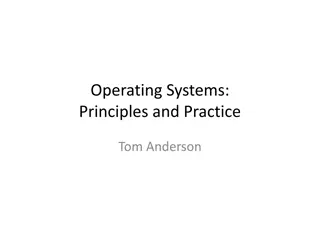Computer Components and Microprocessor: Understanding Computer Architecture
Explore the main computer components and learn about the operation of these components, including inputting, storing, processing, outputting, and controlling. Understand the role of the microprocessor in computer processing and its characteristics such as instruction set, bandwidth, and clock speed.
11 views • 20 slides
Enhancing Food Systems for Improved Food Security and Job Creation
The importance of improving food systems to achieve sustainable development goals and enhance food security and job creation. It covers topics such as the current food systems, the impact of these systems, jobs in the food systems value chain, and key recommendations.
8 views • 24 slides
Understanding Multimedia Systems: Hardware and Software Components
Multimedia systems require specific hardware and software components to meet the demands of producing and playing multimedia content. Development systems are used for creating content with higher specifications, while playback systems are used for playing multimedia files with lower specifications.
8 views • 46 slides
Embedded Systems Design Process in the Embedded systems
Embedded systems are all around us, from the tiny microcontrollers in our household appliances to the sophisticated control systems in cars and aeroplanes. But how are these systems designed? Let's delve into the basics of the embedded systems design process in simple terms that anyone can understan
2 views • 9 slides
Overview of Distributed Systems: Characteristics, Classification, Computation, Communication, and Fault Models
Characterizing Distributed Systems: Multiple autonomous computers with CPUs, memory, storage, and I/O paths, interconnected geographically, shared state, global invariants. Classifying Distributed Systems: Based on synchrony, communication medium, fault models like crash and Byzantine failures. Comp
9 views • 126 slides
Operating Systems
An operating system is a crucial program that manages all other programs on a computer. It handles tasks like input recognition, file management, and device control. There are different types of operating systems such as single-user, single-task systems, multi-user, multi-task systems, real-time ope
6 views • 11 slides
Understanding Microprocessor Architecture and Software Design
Microprocessor architecture and software design play crucial roles in the development of microprocessors. This article explores the internal features, software design types, and characteristics of Complex Instruction Set Computer (CISC) and Reduce Instruction Set Computer (RISC) architectures. It de
7 views • 73 slides
Understanding Information Systems in Organizational Management
Management in organizations is divided into three levels: operational, tactical, and strategic. Each level requires different information systems to support various activities. Operational systems focus on routine transactions and control processes, while middle-level systems aid in semi-structured
8 views • 39 slides
Understanding Negative Results in Systems Research
Systems research encompasses various areas such as operating systems, networking, and distributed systems. Negative results in systems research often go unpublished, leading researchers to focus on curating positive outcomes. This practice can hinder the credibility of scientific findings and impede
5 views • 23 slides
Explore the Top 5 Trends in Alarm Systems with Shellharbour Security Systems
Explore the latest trends in alarm systems with Shellharbour Security Systems. Learn about advancements such as smart home integration, wireless technology, AI-powered monitoring, and more. Stay informed to enhance your home or business security with cutting-edge solutions. Visit: \/\/shellharbourse
7 views • 8 slides
Understanding Management Information Systems (MIS)
Management Information Systems (MIS) are vital for collecting, processing, and analyzing data in business activities. They assist decision makers, facilitate communication, and maintain records. Components include people, data, business procedures, hardware, and software. Various types of informatio
1 views • 11 slides
Number Systems In History
Civilizations throughout history have expressed their values and beliefs through various creative forms like architecture, music, and literature. The development of numbering systems played a crucial role in advancing society's ability to communicate, track records, and engage in trade. From the ear
1 views • 17 slides
Comprehensive Guide to 8085 Microprocessor Interrupts and Pin Diagram
Explore the PIN diagram of the 8085 microprocessor, understand interrupts, including hardware interrupts like TRAP, RST, INTR, and the classification of interrupts such as maskable, non-maskable, vectored, and more. Learn about the sequence of steps during interrupts and their significance in microp
11 views • 31 slides
Understanding Microcontrollers in Electronics and Communication Engineering
Microcontrollers play a crucial role in embedded systems by combining a microprocessor, memory, I/O ports, and timers on a single chip. They differ from microprocessors in terms of architecture, power consumption, and applications. This content covers the basics of microcontrollers, including the di
0 views • 62 slides
Understanding Timing Diagrams and Machine Cycles in Microprocessors
Timing diagrams provide a visual representation of execution times for instructions in a microprocessor, measured in T-states. This content delves into the concept of machine cycles, such as Opcode fetch cycle and Memory read cycle, in 8085 microprocessors. Exploring the T-states within each cycle,
0 views • 27 slides
Introduction to Database Management System Explained
This presentation covers the basics of database management systems, including definitions of data, types of data, structured and unstructured data, storing data in computers using file systems and database systems, and issues with file systems like data redundancy, inconsistency, difficult data acce
1 views • 18 slides
Understanding Different Types of Recommender Systems
Recommender systems play a crucial role in providing personalized recommendations to users. This article delves into various types of recommender systems including Collaborative Filtering, Content-Based, Knowledge-Based, and Group Recommender Systems. Collaborative Filtering involves making predicti
0 views • 7 slides
Understanding Number Systems and Their Characteristics
Dive into the world of number systems, exploring non-positional and positional systems. Learn about the unique features of each system, including the use of symbols and digits, as well as how to convert numbers between different bases. Discover the Decimal Number System and its significance in every
2 views • 33 slides
Efficient Greenhouse Cooling Systems for Smart Agriculture
Active summer cooling systems like fan-and-pad and fog systems are crucial for maintaining optimal temperatures in greenhouses. These systems work by utilizing evaporation to remove heat from the air. Fan-and-pad cooling systems have been in use since 1954, where water is passed through pads to cool
1 views • 23 slides
Understanding Instruments in Instrumentation and Measurement
Passive and active instruments play key roles in measurement, with null-type and deflection-type instruments providing different ways to display values. Analogue and digital instruments offer varying outputs, while indicating instruments and those with signal outputs serve different purposes. Smart
2 views • 12 slides
Interfacing the LED with 8086 Microprocessor - JEPPIAAR INSTITUTE OF TECHNOLOGY
Explore the process of interfacing an LED with the 8086 Microprocessor at JEPPIAAR INSTITUTE OF TECHNOLOGY. Learn about the 8086 Microprocessor, its features, Trainer Board, and the steps involved in the LED interfacing. Discover the internal architecture and operation of the 8086 Microprocessor thr
0 views • 12 slides
Understanding Flag Registers in Microprocessor 8086
This content discusses the flag registers in the Microprocessor 8086, covering conditional flags such as Carry Flag (CF), Auxiliary Flag (AF), Parity Flag (PF), Zero Flag (ZF), Sign Flag (SF), and Overflow Flag (OF), as well as control flags including Trap Flag (TP), Interrupt Flag (IF), and Directi
1 views • 23 slides
Understanding Emergency Communication Systems for Volunteer Training
This content covers various topics related to emergency communication systems for volunteer training, including agency communication systems, government radio systems for police and fire departments, emergency medical radio systems, American Red Cross frequencies, and types of served-agency radio sy
2 views • 29 slides
Introduction to Embedded Systems Design
Embedded Systems Design, Chapter 1 provides an insightful overview of embedded systems, distinguishing them from general-purpose computers. The chapter delves into the characteristics of embedded systems, their design considerations, and the various types of embedded computers such as general-purpos
1 views • 7 slides
Overview of Garments Dyeing Machines: Types and Features
Garments dyeing machines are classified as pedal and rotary types. Pedal machines are manual with higher labor costs, while rotary machines are more advanced, with atmospheric pressure and high-temperature variations. The Atmospheric Pressure Rotary Garments Dyeing Machine is widely used in Banglade
3 views • 9 slides
Evolution of Microprocessors: A Historical Overview
The history of microprocessors traces back to Fairchild Semiconductors in 1959, leading to the founding of Intel in 1968. The evolution from 4-bit to 64-bit microprocessors by Intel revolutionized computing. Key milestones include the Intel 4004 and 4040 (4-bit), 8008, 8080, and 8085 (8-bit), and th
2 views • 44 slides
Understanding the Functional Blocks of the 8086 Microprocessor
The 8086 Microprocessor is a pivotal component in computer systems, with various functional blocks storing results as status bits called flags in the flag register. It performs arithmetic and logic operations, utilizes registers for data storage, features an ALU for generating addresses and instruct
3 views • 41 slides
Information Systems in Organizations: Overview and Implementation
Information systems play a crucial role in organizations, encompassing transaction processing systems, functional area information systems, and enterprise resource planning systems. This content delves into the purpose of transaction processing systems, the support provided by information systems ac
0 views • 30 slides
Understanding Cascade Control Systems in Industrial Processes
Cascade control systems play a crucial role in improving process control efficiency by incorporating feedback loops within feedback loops. This type of control architecture helps to better handle disturbances and variations in the process by creating secondary loops that monitor specific parameters.
0 views • 8 slides
Sustainable Education for Human and Environmental Systems
Sustainable Education for Human and Environmental Systems (SHES) focuses on fostering sustainable societies through social learning and systems thinking. It aims to promote interconnectedness between human and environmental systems, with a vision of enhancing well-being while maintaining the viabili
0 views • 19 slides
Overview of Intel 8086 Microprocessor and Internal Architecture
Intel 8086 microprocessor is a vital component in electronics, with an internal architecture comprising BIU and EU. The BIU handles bus operations, instruction fetching, and address calculation, while the EU executes instructions from the instruction queue. The pin diagram and internal architecture
0 views • 19 slides
Understanding Processor Cycles and Machine Cycles in 8085 Microprocessor
Processor cycles in microprocessors like 8085 involve executing instructions through machine cycles that are essential operations performed by the processor. In the 8085 microprocessor, there are seven basic machine cycles, each serving a specific purpose such as fetching opcodes, reading from memor
0 views • 17 slides
Understanding Microprocessor and Assembly Language at University of Basrah
Discover the world of Microprocessor and Assembly Language through lectures and practical examples at the University of Basrah. Topics include memory segmentation, data registers, arithmetic operations, control structures, and implementing programs to find the maximum of two elements. Dive into the
0 views • 14 slides
Understanding Memory-Mapped I/O in Microprocessor System Design
Explore the concept of memory-mapped I/O in microprocessor-based systems, where I/O devices are accessed through memory addresses. Learn about bus architectures, bus protocols, and examples of read and write transactions, providing insights into how hardware interacts with a simple bus system.
0 views • 43 slides
Trends in Implicit Parallelism and Microprocessor Architectures
Explore the implications of implicit parallelism in microprocessor architectures, addressing performance bottlenecks in processor, memory system, and datapath components. Prof. Vijay More delves into optimizing resource utilization, diverse architectural executions, and the impact on current compute
0 views • 47 slides
Understanding Microprocessor Architecture and Instruction Processing
Explore the basic architecture of a microprocessor, including CPU registers, memory locations, and instruction processing steps. Learn about Intel microprocessor components, addressing modes, and the operation of pipeline microprocessors. Understand the role of control units, ALU, and bus interfaces
0 views • 38 slides
Understanding Embedded Systems and Cyber-Physical Systems
Embedded systems are specialized computer systems embedded within larger systems, such as control systems and car controllers. This lecture covers real-time aspects, applications of Cyber-Physical Systems (CPS), and examples like the Boeing 777/Airbus A380 cockpit. It discusses the design process of
0 views • 22 slides
Memory Address Decoding in 8085 Microprocessor
The 8085 microprocessor with 16 address lines can access 216 locations in physical memory. Utilizing a 74LS138 address decoder, chip select signals are generated for memory block selection. The interfacing involves decoding address lines to enable memory access, with distinctions between RAM and ROM
0 views • 18 slides
Understanding Real-time Software Engineering for Embedded Systems
Embedded systems play a crucial role in controlling various machines and processes. Real-time software engineering focuses on designing systems that respond instantly to events, ensuring correctness and timeliness. Characteristics like continuous operation, unpredictable environment interactions, an
0 views • 59 slides
Understanding Operating Systems: Principles and Practice in CSE Curriculum
Dive into the world of operating systems through the lens of "Operating Systems: Principles and Practice" by Tom Anderson. Discover how this course fits in the UW CSE curriculum, covering systems programming, operating system interfaces, and distributed systems. Explore the project work on building
0 views • 21 slides
